Insulation for sewer pipes: types, selection rules and overview of installation technology
The operation of sewer pipelines is influenced by numerous factors, including cold.In order for the system to function normally even at very low temperatures, it is necessary to select the correct insulation for sewer pipes and install it.
Thermal insulation materials are presented on the market in a wide range, and deciding on a purchase is sometimes quite difficult, don’t you agree? We will help you resolve this issue. The article provides an overview of various types of insulation, describes their characteristics, installation features and application.
The content of the article:
- Rules for choosing insulation
- Mineral wool insulation
- Expanded polystyrene heat insulator for pipes
- Polyurethane foam shells
- Application of foamed polyethylene
- Using foil insulation for pipe insulation
- Foamed rubber as insulation
- Sewer insulation with expanded clay
- Thermal insulating paint as insulation
- When is insulating cable needed?
- Conclusions and useful video on the topic
Rules for choosing insulation
There is a huge selection of insulation materials on the construction market, but not all can be used as insulation for sewer pipes.
The main task of insulation is not to heat the outlet, but to reduce heat exchange between the external environment and the liquid circulating through the pipes.
In order for pipe insulation to effectively perform its main function - heat preservation, it must meet 7 basic requirements:
- have a thermal conductivity coefficient as low as possible;
- retain their properties for a long time;
- withstand large temperature changes;
- have good waterproofing properties;
- be resistant to aggressive environmental influences;
- do not support combustion and do not emit toxic smoke;
- be easy to install.
Subject to insulation external sewer pipes and a main line laid in an unheated room. The only exceptions are those regions where even in winter it never drops below 0°C.
For others, the only question is the choice of method and material. Insulation materials are chosen based on the reputation of the manufacturer or brand, but the surest way is to focus on the material of manufacture.
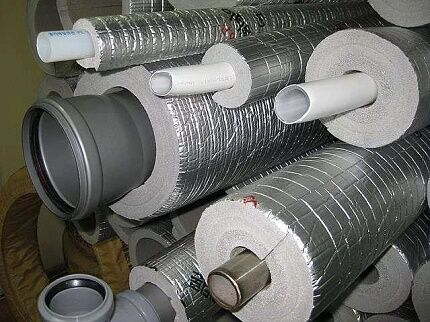
Most often, sewer pipes are insulated with mineral wool, expanded clay, styrofoam and polyurethane foam insulation. Liquid insulation also finds its use. All of them are used for passive insulation.
In addition to them, there are 2 more options for protecting pipes from frost - laying below the freezing level of soil layers and using active insulation. The latter includes cable insulation.
Mineral wool insulation
From the definition established by GOST 31913-2011, we can conclude that mineral wool should be classified as a fibrous material, in the production of which melts of rocks and metal slag are used.
The concept itself combines 3 types of material:
- fiberglass;
- slag;
- stone wool.
They have different thickness and fiber length, different thermal conductivity, moisture resistance, they react differently to mechanical loads, but the composition is identical in all. The characteristics of mineral wool produced by different manufacturers also differ.
The basis of mineral wool is rocks, it contains about 90%. The rest comes from additives - bentonite clay and phenol-based resins.
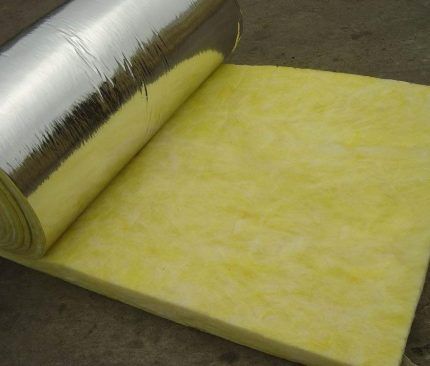
Mineral wool has a number of qualities that make you think before making a choice in its favor.
The disadvantages of insulation include:
- the presence of formaldehyde resins in its composition, which negatively affect health;
- the ability to shrink under the influence of mechanical loads and, as a consequence, the appearance of “cold bridges”;
- high water absorption due to which the insulation needs good waterproofing.
Cotton insulation is used for arranging open sections of sewer pipelines. They are not laid around pipes located in the ground.
When wet, this type of thermal insulation almost completely loses its qualities and often causes rust to appear on metal underground communications.
Installation of thermal insulation from mineral wool is carried out in 3 stages:
- Foil tape is glued onto the pipes in the form of a spiral.
- The pipe is tightly wrapped with insulation. In this case, the seams at the joints must match.
- Thermal insulation is attached to the pipes by wrapping it with plumbing tape.
Taking into account the fact that the density of the material is low and it absorbs moisture well, waterproofing will be required. To do this, use foil or roofing felt. The presence of a foil layer on the insulation makes the task easier, but the ends will still have to be insulated.
Insulation of pipes with glass wool
Glass wool, as one of the options for mineral wool, has all its positive and negative characteristics. It is a natural material obtained from raw materials such as quartzite or sand.
The thermal conductivity coefficient of this heat insulator is in the range of 0.028-0.034. The greater the thickness, the smaller it is. The average density is 150-200 kg/mᶾ.
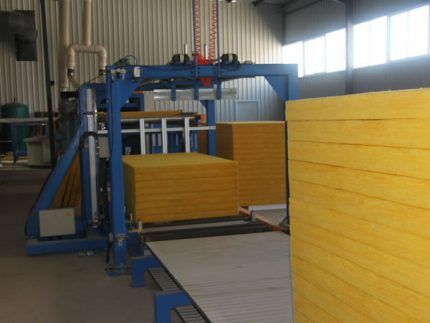
To reduce hygroscopicity, some manufacturers produce glass wool with a ready-made insulation layer. It can be either foil or fiberglass. These include such popular insulation materials as Ursa, Knauf, Izover. Fiberglass heat insulator comes to the construction market in the form of mats, rolls, and cylinders.
Is it possible to insulate sewer pipes with slag wool?
The material is a by-product of iron smelting technology. Slag wool has a loose structure and one very unpleasant feature characteristic of blast furnace products - residual acidity.
Under moisture conditions, acids form on the surface isolated by this material, which negatively affects both metal and plastic. Slag wool melts at a temperature of 300°C, has a thermal conductivity coefficient of 0.46-0.48, and a fiber thickness ranging from 4 to 12 microns. Has low environmental friendliness
The water absorption coefficient of this insulation for sewer pipes is higher than that of glass wool. The material is not resistant to temperature changes, therefore its service life is short.
For this reason, it, like other cotton options, is rarely used for insulating sewer pipes; it is used only for insulating above-ground sections of communications.
The starting material for its production of mineral wool is rocks. Basalt wool is a durable material with a density of 25-200 g/mᶾ and a low thermal conductivity coefficient of 0.03 - 0.04.
It is very resistant to temperature changes - it does not lose its original properties in the range of -60 + 200°C, and begins to melt when the temperature rises above 1000°C.

Stone wool fibers have the same parameters as slag wool, but they are much more elastic. Therefore, they do not break, do not enter the respiratory system, and do not irritate the skin. But this type of mineral wool also has disadvantages - high cost, insufficient strength and the same phenolic substance in some brands of material.
Expanded polystyrene heat insulator for pipes
Foam shells are a popular insulation material for insulating sewer pipes.Two percent of its composition is small, from 1 to 5 mm, polystyrene granules, the remaining 98% is air. After processing the material with a gas-forming agent, the granules become light, elastic, attract each other and stick together.
By pressing followed by high-temperature steam treatment, the material is given the desired shape.
It's basically just foam, but in a shell shape that's designed to last over and over again. The difference between the thermal conductivity coefficient of polystyrene foam insulation (0.03-0.05) and mineral wool is small. The shell, which has the shape of a hemisphere, copes with the task of preserving heat quite effectively.
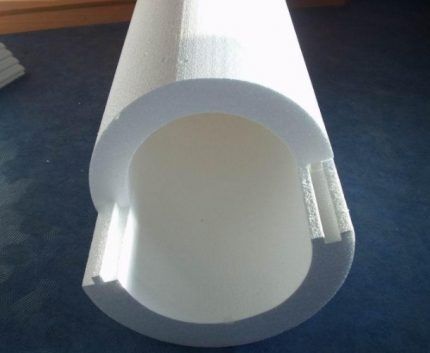
Since foam plastic is not very resistant to mechanical stress, manufacturers provide shells with an outer coating of aluminum foil, fiberglass and other materials.
High thermal insulation properties are provided by thin-walled microcells that do not allow heat to pass through. The service life of the thermal insulation shell is quite long - about 50 years.
There are 2 types of this material - ordinary and extruded polystyrene foam. The characteristics of the latter are higher, but the cost also differs significantly.
Despite a lot of positive qualities, polystyrene foam also has disadvantages. It does not tolerate ultraviolet radiation, so when laying pipes in open areas, additional protection from the sun is required. This material is dense, but fragile, and when burned it can cause poisoning, because The smoke it produces is poisonous.
Installation work is so simple that it does not require special qualifications. Having placed the insulation segments on the sewer pipe, they overlap, displacing them along the length relative to each other by 200-300 mm. To avoid the appearance of cold bridges, the thermal insulation elements are joined together using a quarter or tongue-and-groove system.
After the connection is made, both parts are strongly compressed. The contact points are taped with tape. Sometimes the joints are coated with glue, but then the insulation loses such an advantage as the possibility of reuse, because When dismantling it will have to be cut.
The shell is covered with a protective covering, which comes with it, or simply wrapped with plastic film if it is not available.
The shell is used both on overhead routes and for laying a highway underground. This insulation can be put on a pipe with a minimum diameter of 1.7 cm and a maximum of 122 cm. Already with a diameter of 200 mm, the cylinder consists of 4 elements, and for large products there can be 8.
Trenches with sewer pipes are first filled with sand to a height of about 0.2 m, then with earth. In regions with very cold winters, thermal insulation in the form of a polystyrene foam shell is supplemented with an insulating cable, placing it under the shell.
Polyurethane foam shells
Polyurethane foam cylinders are a good alternative to their foam counterparts. They differ in comparison with their higher density, and the thermal conductivity coefficient is almost the same.
Polyurethane foam also has higher resistance to mechanical stress. It also has a wider temperature range in which it can be operated without loss of strength characteristics.
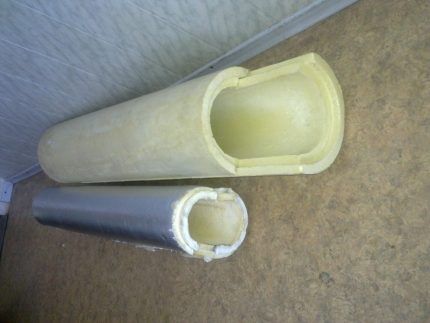
Thermal insulation has the form of half-cylinders equipped with transverse or longitudinal latches. To increase the reliability of protection, the shells are sometimes enclosed in special galvanized casings equipped with locks, but more often they are simply coated with a special coating.
Application of foamed polyethylene
Foamed polyethylene is often used as insulation for sewer pipes. This is not a very dense material - up to 40 kg/mᶾ. The thermal conductivity coefficient is within 0.05.
Does not change its properties when used in the temperature range -50°C - + 90°C.The small thickness of the material allows you to save space, so its use is justified where there is a very small gap between the pipes and the wall.
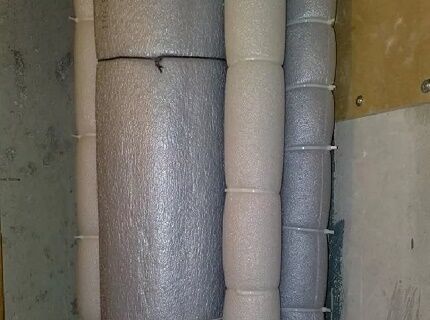
The advantage of insulation is lightness, durability, and affordable price. This insulation is produced by such manufacturers as Magniflex And Penofol, Energoflex, Thermoflex. It is produced in the form of cylinders of different diameters and in rolls. There are foil one and two sided options.
This option of thermal insulation in the installation of sewer pipes is rarely used; it is used to insulate communication areas located in basements and above ground.
Using foil insulation for pipe insulation
Most often the material is used for external communications made of metal-plastic pipes. There are 2 types of folgoizol - SRF and FG. In its production, foil is used - corrugated or aluminum and a bitumen-polymer layer for the binder.
It goes on sale in the form of rolls. The material is durable, environmentally friendly, and has a long service life. Has proven itself well in regions with different climates.
Foamed rubber as insulation
This insulating material is made on the basis of natural or combined rubber. It is characterized by high fire safety and elasticity. Pipe insulation using this material is performed by gluing. As a result of the interpenetration of surfaces, a strong seam is obtained.
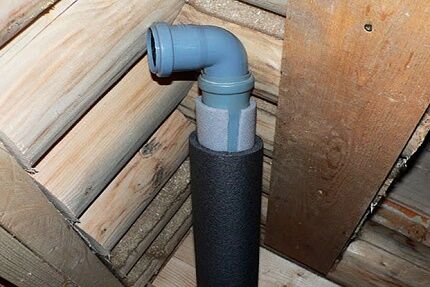
Thermal insulation is produced by such manufacturers as the Italian company K-FLEX, German companies ARMAFLEX And KYFLEX. Due to the high cost, foam rubber is used extremely rarely for insulating sewer pipes.
Sewer insulation with expanded clay
The material is used for thermal insulation of sewer pipes laid underground. Its normal functioning is possible only in a dry environment, so insulation work is carried out in warm, dry weather.
The technology is simple:
- 2 layers of membrane are placed under the pipe with the sheet overlayed on the walls of the trench.
- Expanded clay is poured.
- Lay the edges of the panels overlapping on top of the expanded clay.
When exposed to moisture, this bulk material loses its properties. It is advisable to use it in areas with a temperate climate, because... it is not very effective as insulation.
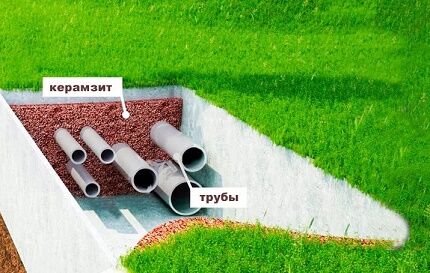
The density of the material depends on its brand. There are several types of expanded clay with different densities, shapes and sizes of granules. High-quality expanded clay has a regular round shape and a uniform internal structure.
Thermal insulating paint as insulation
Visually, heat-insulating paint resembles regular paint. Its advantage is that it can be applied to a surface of any shape. A layer of paint forms a sealed elastic coating that works on the principle of a thermos.
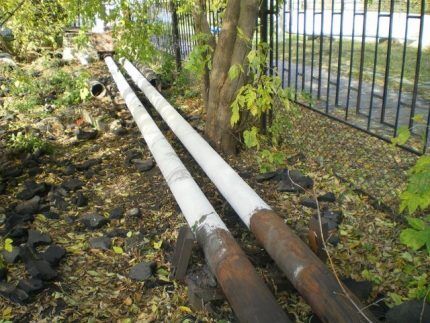
To produce microspheres, ceramics, perlite, foam glass and other substances with thermal insulation properties are used. The paint is very easy to use and creates a durable coating.
The effect of coating with such paint is the same as that of insulation with mineral wool or expanded polystyrene. It is applied either manually using a roller or brush, or by spray.
When is insulating cable needed?
If sewer pipes, due to the impossibility of deepening them, are laid on the surface of the earth, then the most effective way to insulate them will be a combination of several materials plus electrical cable.
The following selection of photos will familiarize you with the installation process of the heating cable:
The same method of insulation is also advisable in the case when the pipes are located at a depth less than the freezing level of the soil.
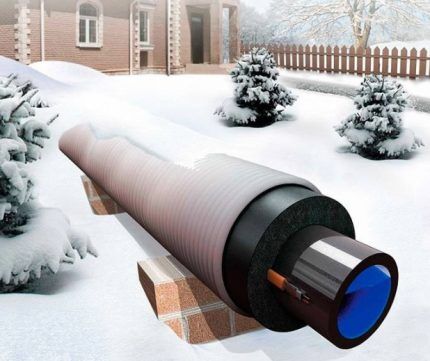
There are two types of products: resistive and self-regulating. In addition to the first, thermostats are definitely needed. It can be either single or 2-core. The most practical option is self-regulating cable, having effective protection against overheating and good thermal conductivity.
Its resistance drops as the temperature decreases and increases as it rises. The third type of cable - zonal - is used when it is necessary to supply heat only to certain areas.
Conclusions and useful video on the topic
The author answers the question about the advisability of insulating pipes located below the freezing level:
Advantages of using thermal insulation cylinders made of extruded polystyrene foam:
Trouble-free service of the sewer system largely depends on the quality of pipe insulation. Of all the existing methods of thermal insulation of sewer pipes, you should choose the one that corresponds to the climatic conditions, the depth of the pipes, and the characteristics of the main line.
Do you have practical skills in insulating sewer pipes? Share your accumulated knowledge, ask questions about the topic of the article and participate in discussions. The communication block is located below.




It seems to me that the appearance of the bulk of materials is more like a marketing ploy. I lived in Kolyma and there we insulated both sewer and water pipes with simple glass wool. Moreover, the pipes were previously laid in concrete or wooden boxes. In principle, this option is quite sufficient both in terms of characteristics and durability.
I don't agree. I myself have used glass wool for a long time, I can say with confidence that it is destroyed under the influence of high humidity and temperature changes. At the new dacha, I insulated the pipes using polystyrene foam shells. This is also a cheap, but much more durable material. To ensure water protection, according to the craftsman involved in the work, an external foil shell of the material is sufficient, which simplifies the installation process. If there is no shell, then regular aluminum foil will do.